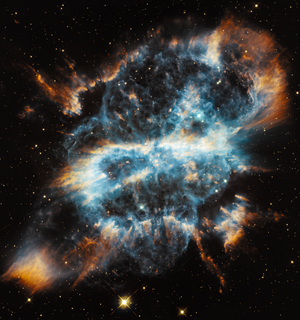| Emission nebula | |
|---|---|
| Planetary nebula | |
 NGC 5189 image taken with the Hubble Space Telescope on July 6, 2012 NGC 5189 image taken with the Hubble Space Telescope on July 6, 2012 | |
| Observation data: J2000.0 epoch | |
| Right ascension | 13 33 32.97 |
| Declination | −65° 58′ 26.7″ |
| Distance | 3000 ly |
| Apparent magnitude (V) | 8.2, 8.5p |
| Apparent dimensions (V) | 90 × 62 arcsec |
| Constellation | Musca |
| Physical characteristics | |
| Radius | ~1 ly |
| Absolute magnitude (V) | - |
| Notable features | A peculiar PN with a binary in the center |
| Designations | Spiral Planetary Nebula, Gum 47, IC 4274, He2-94, Sa2-95, PK 307-3.1 |
| See also: Lists of nebulae | |
NGC 5189 (Gum 47, IC 4274, nicknamed Spiral Planetary Nebula) is a planetary nebula in the constellation Musca. It was discovered by James Dunlop on 1 July 1826, who catalogued it as Δ252. For many years, well into the 1960s, it was thought to be a bright emission nebula. It was Karl Gordon Henize in 1967 who first described NGC 5189 as quasi-planetary based on its spectral emissions.
Seen through the telescope it seems to have an S shape, reminiscent of a barred spiral galaxy. The S shape, together with point-symmetric knots in the nebula, have for a long time hinted to astronomers that a binary central star is present. The Hubble Space Telescope imaging analysis showed that this S shape structure is indeed two dense low-ionization regions: one moving toward the north-east and another one moving toward the south-west of the nebula, which could be a result of a recent outburst from the central star. Observations with the Southern African Large Telescope have finally found a white dwarf companion in a 4.04 day orbit around the rare low-mass Wolf-Rayet type central star of NGC 5189. NGC 5189 is estimated to be 546 parsecs or 1,780 light years away from Earth. Other measurements have yielded results up to 900 parsecs (~3000 light-years).
References
- "NGC 5189 (Mus)". Southern Astronomical Delights. Archived from the original on 14 January 2014.
- Phillips, J. P.; Reay, N. K. (1983). "Ansae and the precession of central stars in planetary nebulae - The cases of NGC 5189 and NGC 6826". Astronomy and Astrophysics. 117: 33–37. Bibcode:1983A&A...117...33P.
- Danehkar, Ashkbiz; Karovska, Margarita; Maksym, W. Peter; Montez, Rodolfo (January 2018). "Mapping Excitation in the Inner Regions of the Planetary Nebula NGC 5189 Using HST WFC3 Imaging". The Astrophysical Journal. 852 (2): 87. arXiv:1711.11111. Bibcode:2018ApJ...852...87D. doi:10.3847/1538-4357/aa9e8c. ISSN 0004-637X. S2CID 119365610.
- Manick, Rajeev; Miszalski, Brent; McBride, Vanessa (1 April 2015). "A radial velocity survey for post-common-envelope Wolf–Rayet central stars of planetary nebulae: first results and discovery of the close binary nucleus of NGC 5189★". Monthly Notices of the Royal Astronomical Society. 448 (2): 1789–1806. arXiv:1501.03373. Bibcode:2015MNRAS.448.1789M. doi:10.1093/mnras/stv074. ISSN 1365-2966. S2CID 118600965.
- "NGC 5189". SIMBAD. Centre de données astronomiques de Strasbourg. Retrieved 21 December 2012.
- Sabin, L.; Vázquez, R.; López, J. A.; García-Díaz, Ma. T.; et al. (2012). "The filamentary Multi-Polar Planetary Nebula NGC 5189" (PDF). Revista Mexicana de Astronomía y Astrofísica. 48: 165–76. arXiv:1203.1297. Bibcode:2012RMxAA..48..165S.
External links
 Media related to NGC 5189 at Wikimedia Commons
Media related to NGC 5189 at Wikimedia Commons- NGC 5189 on WikiSky: DSS2, SDSS, GALEX, IRAS, Hydrogen α, X-Ray, Astrophoto, Sky Map, Articles and images
- NASA Astronomy Picture of the Day: NGC 5189: A Strange Planetary Nebula (11 December 1995)
- NASA Astronomy Picture of the Day: NGC 5189: An Unusually Complex Planetary Nebula (19 December 2012)
- A Cosmic Holiday Ornament, Hubble-Style
- Southern African Large Telescope: Elusive Binary System
| Constellation of Musca | |||||||||||
|---|---|---|---|---|---|---|---|---|---|---|---|
| Stars |
| ||||||||||
| |||||||||||
| |||||||||||
| Nebulae |
| ||||||||||